Thank you, Mr. Chairman for the
opportunity to provide the view of the petroleum geology community on
these important issues. My name is M. Ray Thomasson. I have been a professional
geologist for 41 years, engaged in exploration and development for petroleum
and natural gas. I am currently President of the American Association
of Petroleum Geologists (AAPG), a professional organization composed of
more than 30,000 geoscientists. These men and women are engaged in exploration
and development of energy resources throughout the world, in research
on new exploration and development concepts, and in the education of future
geoscientists for the profession. The AAPG, founded in Tulsa, Oklahoma
in 1917, was chartered to serve the profession through the identification
and application of new science and technology for the discovery and production
of hydrocarbon resources. The application of new exploration and development
concepts has led to more efficient practices that have lowered the cost
of produced products and significantly reduced the environmental consequences
of such activities. The membership of AAPG is proud of their contributions
in supplying the world with reliable and inexpensive energy, in developing
new ways to do that job better, and in the education of new geoscientists
to carry on the tradition.
I would like to note that AAPG
is affiliated with the American Geological Institute, an umbrella organization
representing the geoscience community with offices in the Washington,
D.C. area, and acknowledge their assistance in the development of this
presentation.
Mr. Chairman, crude oil, and more
recently natural gas, have fueled the economic development of our country.
The 200 million vehicles (cars, trucks, and busses) that traverse our
streets and highways, the planes that transport us from coast to coast
and around the world, the ships that bring passengers and goods to and
from our shores, the factories and businesses that produce and distribute
the products we use are powered in large measure by fossil fuels. Today,
the average U.S. citizen uses about 26 barrels of crude oil and 84 thousand
cubic feet of natural gas per year. Thus, the U.S. with less than 5 percent
of the world’s population consumes about 25 percent of the world’s
petroleum production. Compare that with the Far East with 40 percent of
the world’s population that has a per capita consumption of crude
oil of less than one barrel per year and natural-gas consumption that
is too small to measure. The mechanical and thermal energy as well as
the products produced from these fossil fuels are important contributors
to our standard of living. So, it should be no surprise to see other nations
working toward similar goals. Thus, the competition for global supplies
of oil and gas will increase dramatically as these emerging economies
enter the consumer age.
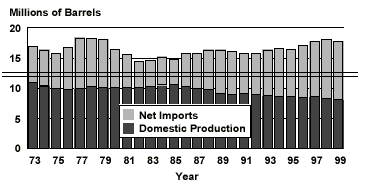
Figure 1. Production versus imports of petroleum from 1973 through 1999.
Today, the U.S.
imports more than one-half of our crude oil and refined products needs.
That amount has increased substantially since our "energy crisis"
of 1973. At that time our imports amounted to only 35 percent of our total
demand. Yet, the result of an embargo by Arab producers was long lines
at service stations with rationing of the amounts that could be purchased.
The petroleum industry responded to that crisis with an increase in exploration
and development. That effort resulted in a net increase in domestic production
and a corresponding decline in imports. However, it is important to note
that the response was not instantaneous. In fact, almost five years passed
before such increases were realized (Figure
1). Construction of new rigs, training of crews, and the exploration
process itself takes a long time. Today, we would be in substantially
worse shape if such an event were to occur because since 1985 domestic
production has declined at an annual average rate of 180 thousand barrels
per day. It should be noted that masked in these data is the fact that
the automotive industry substantially improved the mileage efficiency
of the U.S. automotive fleet. While that had a major effect on transportation
fuel demand during the years following the 1973 crisis, having been done,
it is not likely to be achieved again to such a degree.
Natural gas underwent a similar
decline in production following the energy crisis of 1973 because of myopic
views that the U.S. was running out of gas. Actually, just the opposite
is true, in that the North American natural gas resource base, unlike
oil, is incredibly large and will be able to fuel our economic engine
well into and probably through this century. Unfortunately, legislation
was passed in the mid 1970s that substantially changed the economics of
exploring for and developing natural-gas. The Fuel Use Act prohibited
the use of natural gas for process heat in new facilities and Incremental
Pricing passed on the increased costs of natural gas primarily to the
industrial sector in an effort to reduce that consumption. These actions
reduced the annual base load of natural gas for electric power generation
and other industrial uses and essentially made natural gas a winter heating
fuel. Thus, the substantial fluctuation in demand between summer and winter
caused corresponding large fluctuations in price leading to declining
economic performance, especially for small producers. Domestic production
declined from 22.6 trillion cubic feet per year in 1973 to 15.8 trillion
cubic feet in 1983. In the late 1980s, the industry increased drilling
activities, propelled by rising commodity prices and the application of
new technologies, and by 1997 production increased to 19.4 trillion cubic
feet. Since then it has remained essentially constant. However, demand
continued to rise to 22 trillion cubic feet in 1999. This increase in
demand in excess of domestic production has been met with imports, largely
from Canada.
Mr. Chairman, the questions that
need to be asked are why is the domestic production of crude oil declining
and why is the production of natural gas essentially flat? One answer
that is commonly expressed is that the U.S. is running out of opportunities to discover new reserves of oil and gas. That statement is only partially
correct. Please note the emphasis on opportunities. Because of changes
in the tax code and increasing restrictions in access to public lands,
the U.S. petroleum industry is facing declining opportunities to develop
those commodities that are present.
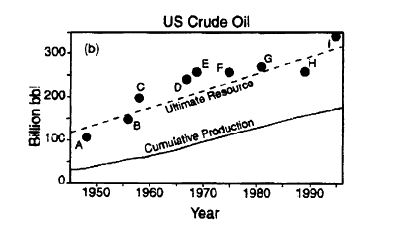
Figure 2. Graph depicting resource estimates of U.S. crude oil resources with respect to cumulative production. The estimates were made by various groups through time. The most recent (labeled I) is that of the U.S.G.S. and Minerals Management Service.
However, some
will argue that the resources are not there to be found. That is simply
not true. From the first effort to estimate the U.S. resources to present,
there have been numerous predictions about the demise of our supplies
of petroleum and natural gas. Each of those predictions has been proven
blatantly wrong. An illustration of previous estimates of remaining crude-oil
resources in the U.S. may help to understand this statement. Figure
2 shows 10 historical estimates of the ultimate size of the U.S. crude
oil resource versus cumulative production. Note that the size of the resource
has "grown" slightly faster than has cumulative production.
What this illustration implies is that the more we learn about even the
most mature petroleum-producing basins in the U.S., the more resources
we discover. The resource has always been there; it is new science and
technology that is permitting us to do a better job of assessing the economic
amounts that are present. The most recent assessment by the U.S. Geological
Survey, as have all prior assessments, demonstrates that the petroleum
and natural-gas resource base is large enough to sustain an active domestic
petroleum industry for many decades. The next assessment probably will
demonstrate a similar growth because we are far from reaching the limit
on the applications of new science and technology in the petroleum industry.
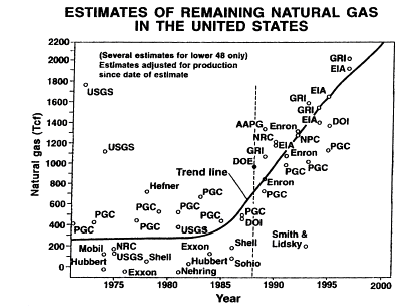
Figure 3. Estimates of remaining natural gas in the U.S. Estimates are from a variety of sources (Fisher, 1999).
Mr. Chairman,
the problems of accurately assessing remaining resources is particularly
well shown in figure 3. In the
15-year period from 1985 to 2000, the estimates of remaining natural gas
in the United States have grown from about 300 trillion cubic feet to
more than 2,000 trillion cubic feet. The reason for this is displayed
in figure 4 which shows that with
increasing technological capability, the industry can economically recover
an increasing volume of resources. This is, in large part why we have
been able to date to meet the growing demand for natural gas in this country.
I want to caution you as well in
your evaluation of the numbers you see for estimates of remaining oil
resources. Most estimates, such as those made by Campbell and others,
are for conventional resources. In fact, 65 percent of our production
of oil today is from so-called unconventional resources. Because, with
technology and experience, unconventional resources become conventional
and our resource numbers continue to increase.
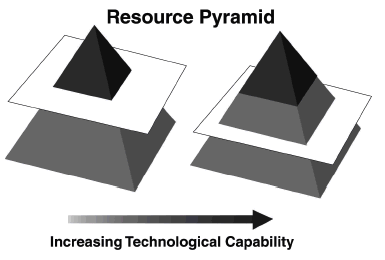
Figure 4. Resource pyramid showing an exponential increase in volume of resource due to increasing technological capabilities.
The real question, Mr. Chairman,
is how important is domestic crude oil and natural gas? Is it important
enough to permit access to prospective public-lands for exploration and
development? Is it important enough to provide appropriate economic incentives
for that development? Or, as the present policy seems to be, should we
depend more upon other countries to supply our future petroleum needs
and not encourage the development of our domestic resources. I need not
remind you of the trauma faced by this country in our one experience with
an energy crisis in spite of the fact that during that time we lost only
5 percent of our crude oil supply, the amount supplied by Arab OPEC countries.
If a 5 percent decline could cause the problems that we had then, think
of what would happen today if we lost our imports from the same sources
as before.
Many will say that it could never
happen again, but most did not believe that it would happen the first
time. Witness the fact that we had no contingency for that event. Today,
with more than 50 percent of our petroleum coming from non-U.S. sources,
our strategic petroleum reserve would provide very little relief from
a major disruption in supply, the reason for which it was established.
In fact, it is a deterrent to our facing the reality of the situation
because it is giving us a false sense of security. In addition, it is
looked upon by some to be a quick fix for high oil prices rather than
the supply security reserve it was established to be.
While crude oil remains a problem,
natural gas is an entirely different matter. Crude oil and refined products
can be moved between world markets with relative ease, but natural gas
cannot. Natural gas is a North American continental commodity. The natural
gas that we need must come from U.S. production as well as imported from
our friendly neighbors in Canada and Mexico. Although, Mexico is not a
likely source of supply in the foreseeable future. In fact, we are now
exporting a small, but increasing, amount of natural gas to Mexico for
the growing industrial development just south of our border.
The only alternative to these North
American gas sources would be the importation of liquefied natural gas.
The fully amortized cost of such gas would be in excess of $5.00 per thousand
cubic feet at present prices or essentially double the current market
price for natural gas. The likely consumer outrage of having to pay that
price would make the current concern over high gasoline and heating oil
prices seem benign in comparison.
Mr. Chairman, assessments by the
Gas Research Institute and the Energy Information Administration each
show a demand for as much as 32 trillion cubic feet per year over the
next 15 to 20 years. These forecasts are based upon rapidly escalating
increases in usage of natural gas for electric-power generation and other
industrial and commercial uses where a less polluting fuel is needed.
This essentially is a 50 percent increase over current domestic production.
At present levels of exploration and development activity, we are barely
replacing our current annual production with newly discovered reserves.
To increase that production by 50 percent over that time frame will require
a very large increase in drilling activity.
Once before, the U.S. increased
production of natural gas by that amount over a 15-year period. However,
at that time we had a healthy petroleum industry with about 4,000 drilling
rigs and access to prospective lands. Today, we have a substantially diminished
industry with fewer than 1,000 active rigs and growing restrictions to
prospective lands. If federal restrictions and regulatory burdens in accessing
public lands continue as they are today, there is little chance that we
will be able to achieve those projected higher production rates. In fact,
we may be unable to sustain current levels of production beyond the next
few years unless actions are taken now to increase access to public lands
and improve economic conditions conducive for exploration and development.
To demonstrate that good things
can happen when conditions are right, since 1967 in excess of 300 exploratory
wells have been drilled within the offshore outer continental shelf waters
of the Canadian Atlantic. To date, at least 12 trillion cubic feet of
natural gas and 2 billion barrels of oil have been discovered. These discoveries
have been off the Scotian Shelf, the Grand Banks and even the Labrador
Sea. The Hibernia platform, 150 miles off the east coast of Newfoundland,
is now producing more than 125,000 barrels of oil per day from a large
platform on the prolific fishing grounds of the Grand Banks. Natural-gas
production of 400 million cubic feet per day began at the end of last
year from the Sable Offshore Energy Project, off the coast of Nova Scotia,
just a few hundred miles north of Boston. A majority of that gas will
be serving the New England market from these off shore production platforms.
Assessments to date of the Eastern Canadian offshore indicate that the
region contains in excess of 50 trillion cubic feet of natural gas and
10 billion barrels of oil. All of this is being accomplished within the
prime commercial fishing waters and the pristine tourist coastlines of
Eastern Canada. In fact, for more than thirty years offshore exploration
and production calmly have co-existed with tourism and commercial fishing
for the betterment of all concerned.
Many experts agree that these types
of oil and gas accumulations in the Eastern Canadian offshore extend south
along the U.S. Atlantic from Georges Bank on the north to the Carolina
Trough to the south, a distance of almost 1,000 miles. In fact, a recent
major gas discovery announced by PanCanadian Petroleum of Calgary, in
a long, subsurface carbonate reef-styled formation suggests to many that
similar potential extends far down the East Coast of the United States,
and perhaps even as far as Florida. Nova Scotia, like Florida and the
other Eastern seaboard states, has a thriving tourism industry. Yet, tourism,
fishing, and offshore petroleum production co-exist in a cooperative and
even supportive environment. Simply put, Canada has been able to develop
their precious resources in a safe and rational manner. Given our circumstances,
especially with respect to natural gas, it is difficult to understand
why we cannot do the same, especially since offshore natural gas development
poses little threat to any coastline, and significant reserves have already
been discovered off New Jersey and Florida years ago. We can do this in
the U.S., if only we have the courage to work together as our Canadian
neighbors have done among themselves.
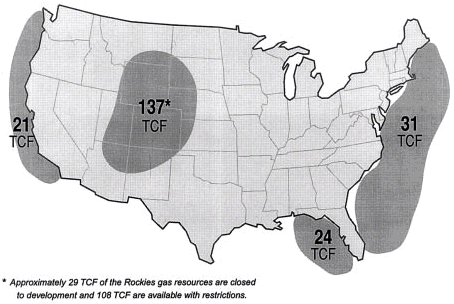
Figure 5. An illustration from the report by the National Petroleum Council on Natural Gas showing estimated volumes of natural-gas resources that are subject to access restrictions.
• Significant amount of resource is subject to access restrictions.
• These areas are close to large and growing population centers.
Mr. Chairman,
the National Petroleum Council has released recently a comprehensive assessment
of the natural-gas supply and demand situation in the United States. I
urge you and your colleagues to examine this document carefully because
it contains valuable information that should have a bearing on matters
before your committee. I wish only to summarize a few points from their
extensive study. They conclude, as have others, that the resource base
is sufficient to support the expected growth in demand. However, they
note that a substantial portion of that resource base is, at present,
either not accessible due to federal moratoria or accessible with onerous
restrictions that destroy the economic viability of development (Figure
5).
The NPC study
also notes that a significant increase in capital expenditures will be
required to achieve the projected growth in natural-gas demand. For increased
exploration and production alone, the capital expenditures will have to
be increased from a current rate of about 32 billion per year to more
than 50 billion per year by 2015 (Figure
6). Given today’s financial climate, that will happen only if
appropriate incentives are provided to the industry.
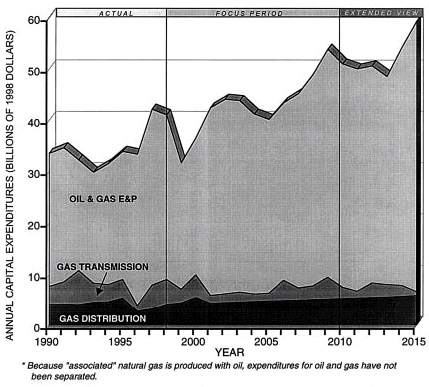
Figure 6. An illustration from the National Petroleum Council report on Natural Gas showing the estimated increase in required capital to develop the projected demand for natural gas supplies.
• Substantial increase in capital expenditures will be required.
• Total capital expenditures for 1999-2015 will be $785 billion. (Source of historical data: AGA Gas Facts-1998, and estimates from EEA, Inc.)
Mr. Chairman, I believe that we
have provided information to demonstrate that the industry can and will
be able to provide the oil and gas supplies needed by this Nation for
the economic stability to permit continued growth and prosperity. However,
to do so, the Congress must address two issues. These are improved access
to public lands and appropriate incentives to provide for capital generation.
Public lands contain a substantial
portion of the undeveloped oil and gas resources of this Nation. They
have been under developed with respect to state and fee lands, and thus
contain a disproportionate share of the remaining resource base. There
are essentially two types of restrictions on public lands, non-accessible
and accessible with restrictions. The offshore East Coast is an example
of non-accessible lands and some of the Rocky Mountain basins are examples
of accessible with restrictions.
The Canadian government has demonstrated
its willingness to go forward with the development of its offshore resources,
and that is being accomplished in a safe and compatible manner with the
prime commercial fishing area of their country. They also enjoy a bountiful
tourism industry, which is unaffected by this resource development activity.
We believe the resources in the offshore of our East Coast and those of
the Eastern Gulf should be opened to access as well. The concern over
oil spills has been consistently overstated. Except for two incidents
over the last 50 years, one off the coast of California over three decades
ago and the other off Mexico in the 1980s, neither of which should have
happened, all major spills have come from tanker accidents. Our risk exposure
to future large tanker spills increases, given our increasing need for
crude oil and refined product imports. The oil that we fail to produce
in the U.S. will be delivered by an ever-increasing fleet of tankers with
the corresponding risk of more such spills.
We believe that the 1002 area of
the Arctic National Wildlife Refuge (ANWR), as well as the similar coastal
plain area of the National Petroleum Reserve—Alaska (NPRA), should
be opened to exploration and development. The 1002 area represents less
than 10 percent of the 19 million acres of ANWR. Experts believe that
it contains technically recoverable oil resources of 4.3 to 11.8 billion
barrels. Less than 1 percent of the land within the 1002 area would be
affected by petroleum exploration and development activities. The coastal
plane of the NPRA, recently held back by the BLM from last year’s
lease sale at the instruction of the Secretary of the Interior contains
at least an estimated 1.5 billion barrels. The Alaska pipeline, that has
delivered a significant quantity of oil during its life span, is now down
to transporting only about 1 million barrels per day. Unless new reserves
are developed on the North Slope in the near future, the volume of oil
that it carries will continue to decline. At some point, estimated to
be about 600 thousand barrels per day, the operation will become uneconomic
and will have to be terminated. At that point, based on present legislation,
the pipeline may have to be removed. The adverse consequences of that
for Alaska and the Nation would be substantial.
We believe that processes used
by the Department of the Interior in managing the resources on public
lands in the Rocky Mountain region and elsewhere need to be reformed with
respect to petroleum exploration access and development. The extensive
delays in granting access for exploration and in permits for pipelines
to deliver natural gas to markets adds substantial costs to such projects
to the point of making many uneconomical. The industry has repeatedly
demonstrated the ability to operate in sensitive areas without damage
to either the environment or the wildlife that inhabit those environments.
Therefore, we would request that the Congress seriously consider reforming
both the Clean Water Act and the Endangered Species Act, especially pertaining
to wetlands designations, and create preemptive legislation to thwart
the EPA’s efforts to severely regulate the use of hydraulic fluid
bore-hole fracturing methods. All three of these regulatory or legislative
burdens significantly hinder the development of our Nation’s energy
supplies.
The total area of the U.S. Federal
Outer Continental Shelf is about 2 billion acres, of which only about
2 percent has been leased. In its 1995 study, the Minerals Management
Service assessed a mean undiscovered recoverable resource of 46 billion
barrels of oil and 268 trillion cubic feet of natural gas. This is 2.5
times the offshore reserves found to date. Sadly, most of these public
lands are now "off limits" for exploration and development.
Further, we believe that no additional
areas of public lands should be removed from access, and especially by
the sole action of the President of the United States, until a proper
assessment of their resource potential is conducted. Such assessments
must include the use of modern technology, including high resolution seismic
exploration methods as well as all new methods of modern exploratory drilling
technology to determine an area’s potential for the development of
existing natural resources.
Mr. Chairman, while I recognize
that economic incentives are not within the scope of this Committee, I
would like to add a few comments on this subject because it is equally
important to the industry in meeting the substantial challenge of providing
this Nation with needed future energy resources. Because of fundamental
changes in the structure of the industry, many of our largest companies
are devoting most of their attention to exploration and development opportunities
overseas. Thus, the number and size of the operators that are left to
develop the remaining resources in the U.S. are smaller on both accounts.
Historically, small companies and independent operators have drilled most
of the wells in the onshore of the U.S. In the future, we expect these
operators to drill virtually all of the onshore wells. While most of the
larger companies and a few of the smaller operators conduct exploration
and development using internally generated funds, the vast majority must
rely on external capital for such activities. In addition to those mentioned
previously, we believe the following issues need to be addressed by the
Congress:
- Examine the existing
permitting process to make sure that permits are executed in a timely
and reasonable manner.
- Establish certainty
with respect to timing and area of off shore lease sales
- Restoration of the
write-off of intangible drilling costs for the passive investor (doctors,
lawyers, and other non-industry people).
- Eliminate the onerous
Alternative Minimum Tax, which cripples investment.
- Expensing of delay
rentals in the year incurred, not capitalizing them as currently required.
- Expensing of geological
and geophysical costs.
- Make permanent the
suspension of the net income limit for percentage depletion on marginal
properties.
- Raise the depletion
allowance provision to previous levels.
Petroleum exploration and production
are extremely capital intensive and the role of taxation is critically
important to the development of oil and gas resources. The U.S. tax code
currently contains these onerous provisions which serve as major disincentives
to these activities. Major tax reform that more fairly treats capital
in its efforts to find and develop new sources of domestic oil and gas
will dramatically help our ability to provide safer and more secure resources.
In summary, Mr. Chairman, I have
attempted to provide a picture of our present energy situation, and the
challenges that we face in meeting the demands for the future. With proper
consideration by the Congress for those matters that need your attention,
I am confident that the domestic petroleum exploration and production
industry can deliver the oil and gas resources needed to help maintain
this country on a course of continuing prosperity.
Absent attention to improved access
to public lands and fairer tax and regulatory treatment to provide reasonable
incentives and opportunities, we will continue to jeopardize our Nation’s
economic stability, and thus our own national security. Our continued
inattention to these potentially dangerous problems, should concern us
all. Time is running out. You need to act on these reforms soon. Let’s
make it happen!
Dr. M. Ray Thomasson
President, American Association of
Petroleum Geologists